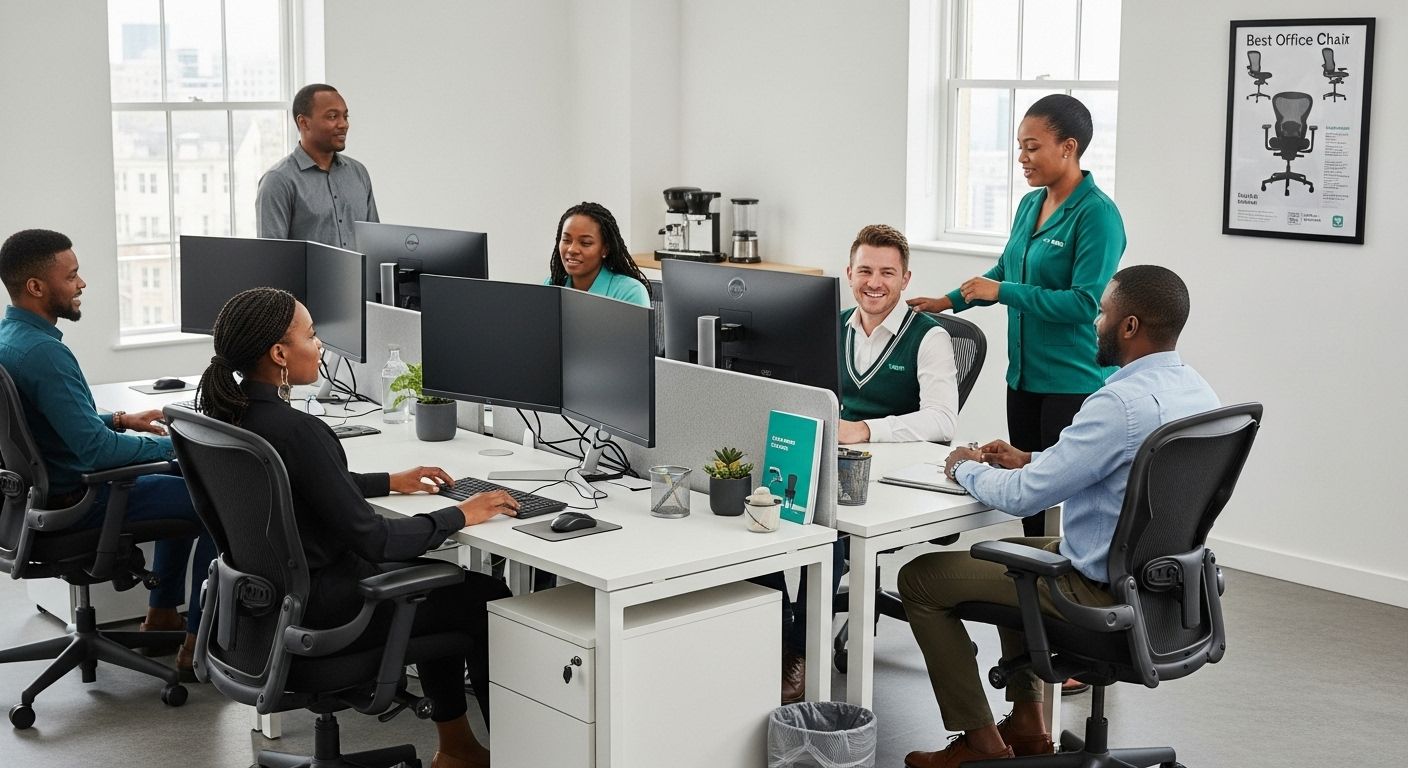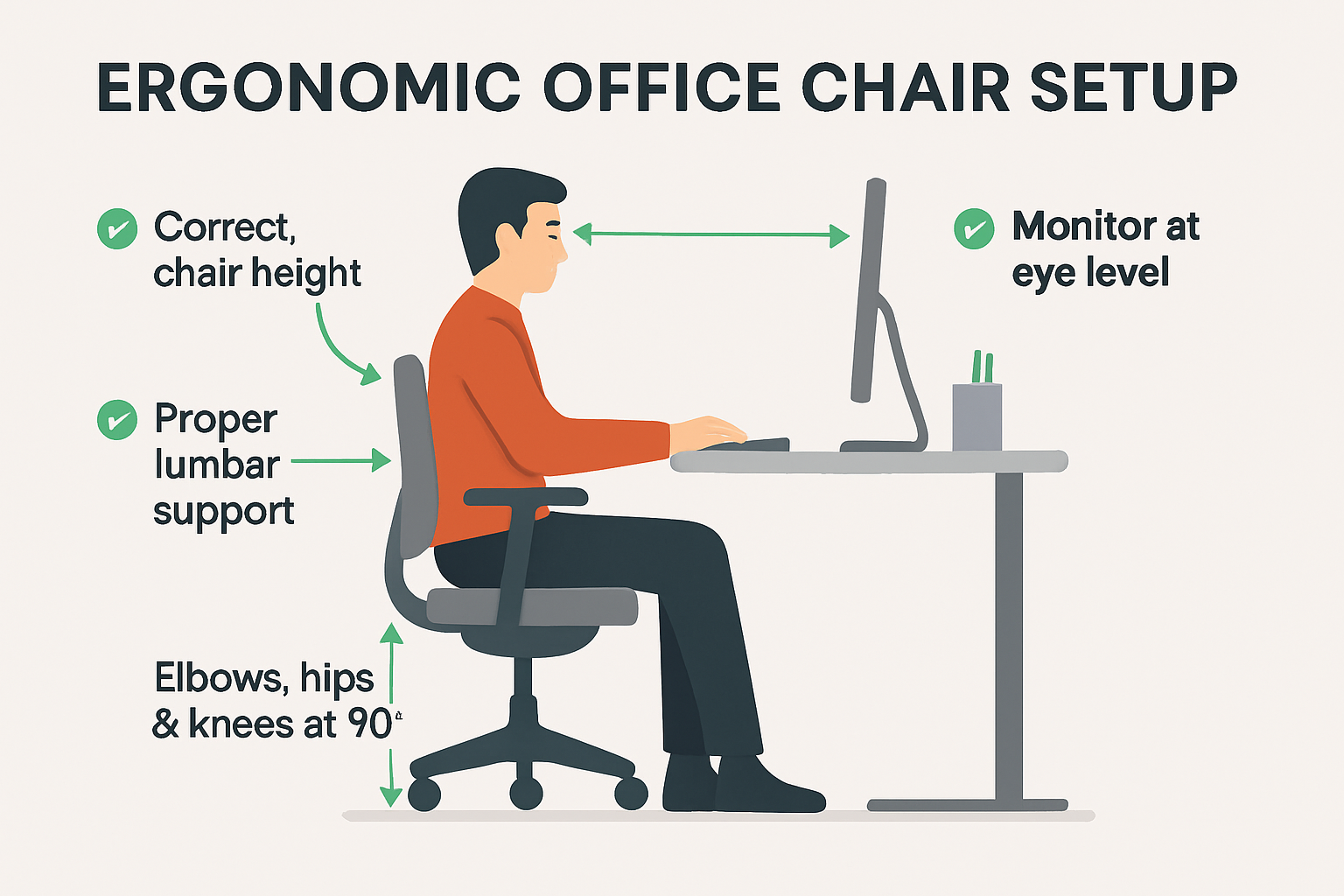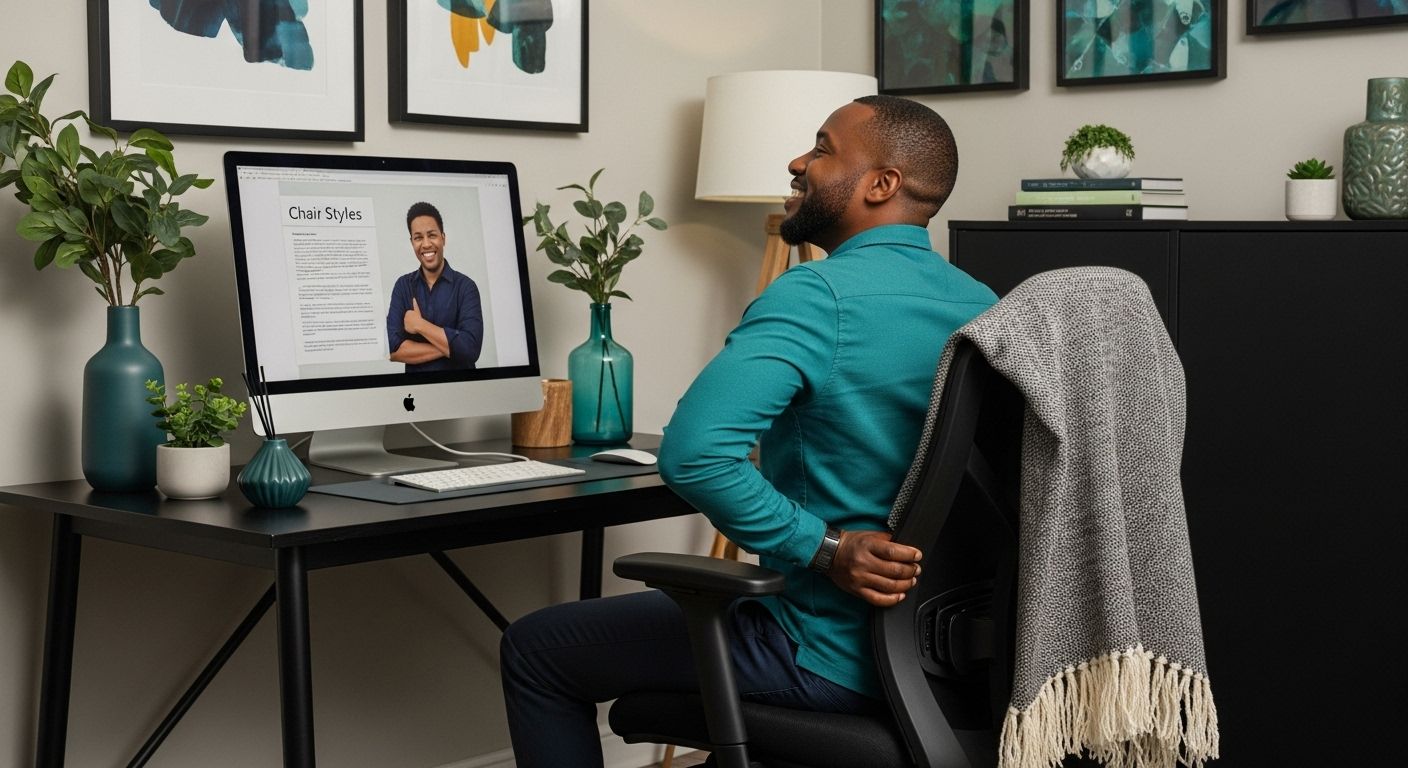Best Office Chair Posture for South African Workspaces 2025
2nd Aug 2025
Best Office Chair Posture for South African Workspaces 2025

Sitting at your desk all day might seem harmless, especially with so many South Africans working from offices or at home. Shockingly, studies have linked poor sitting posture with up to a 54 percent higher risk of developing chronic back pain and long-term musculoskeletal problems. Most people shuffle around trying to get comfortable but ignore one critical fact. The best office chair posture is not about sitting still at all. It is about constant movement and small adjustments that keep your body healthy and your focus sharp.
Table of Contents
- Why Good Office Chair Posture Matters
- How to Set Up the Best Office Chair Posture
- Top Office Chairs for Proper Posture in South Africa
- Tips for Maintaining Healthy Posture at Work
Quick Summary
| Takeaway | Explanation |
|---|---|
| Maintain Proper Chair Height | Your feet should rest flat on the floor with your knees at a 90-degree angle to prevent back strain. |
| Ensure Lumbar Support | Adjust the lumbar support to fit the natural curve of your lower back, promoting healthy spinal alignment. |
| Practice Dynamic Sitting | Regularly change your position and incorporate standing or moving breaks to enhance circulation and reduce stiffness. |
| Incorporate Regular Stretching | Perform desk stretches and short walking breaks to counteract the effects of prolonged sitting. |
| Choose an Ergonomic Chair | Select chairs with adjustable features like seat height and lumbar support for personalized comfort and posture management. |
Why Good Office Chair Posture Matters
In the fast-paced world of South African workspaces, understanding the critical importance of good office chair posture goes far beyond mere comfort. It represents a fundamental aspect of workplace health, productivity, and long-term physical well-being.
The Hidden Health Risks of Poor Sitting Posture
Prolonged sitting has become an unavoidable reality for many professionals, but the consequences of incorrect posture can be devastating. Research published in a comprehensive ergonomic study revealed alarming insights into the impact of prolonged sitting. Workers who maintain poor posture are at significant risk of developing musculoskeletal disorders, chronic pain, and long-term spinal complications.
The human body is not designed for extended periods of static positioning. When seated incorrectly, individuals experience increased pressure on the lumbar spine, which can lead to chronic lower back pain, reduced muscle flexibility, and decreased overall physical performance. These issues are not merely temporary discomforts but can result in permanent structural changes to the spine and muscular system.
Productivity and Performance Implications
Beyond physical health, poor posture directly impacts workplace productivity. A study examining office ergonomics training demonstrated that workers with proper ergonomic support and posture training showed significant improvements in work performance and reduced musculoskeletal risks.
Good posture facilitates better breathing, improved blood circulation, and enhanced cognitive function. When your body is correctly aligned, you experience less fatigue, maintain higher energy levels, and can concentrate more effectively on complex tasks. This translates into tangible benefits for both individual workers and organizations seeking to optimize workplace efficiency.
Comprehensive Posture Management Strategy
Addressing office chair posture requires a holistic approach. It’s not just about selecting an ergonomic chair but understanding how to use it correctly. A systematic review of workplace interventions highlighted that while ergonomic chairs are crucial, employee education plays an equally important role in maintaining proper posture.
Key elements of a comprehensive posture management strategy include:
- Chair Adjustment: Understanding how to customize chair settings to individual body types
- Regular Movement: Implementing short breaks and stretching routines
- Ergonomic Awareness: Training employees about the importance of maintaining correct sitting positions
For South African professionals seeking comprehensive workplace solutions, explore our ergonomic office furniture guide to learn more about creating a health-conscious workspace.
Ultimately, good office chair posture is an investment in personal health, professional performance, and long-term physical well-being. By prioritizing proper sitting techniques and ergonomic support, workers can transform their daily work experience and protect themselves from potential long-term health complications.
Here is a summary table outlining the core elements of a comprehensive posture management strategy for South African workspaces:
| Strategy Element | Purpose/Benefit |
|---|---|
| Chair Adjustment | Customise chair settings for individual body types |
| Regular Movement | Prevents stiffness and supports muscle health |
| Ergonomic Awareness | Educates employees to maintain correct sitting positions |
| Short Breaks & Stretching | Reduces fatigue, improves blood flow, and relieves muscular tension |
| Employee Education | Long-term habit development for workplace health |
How to Set Up the Best Office Chair Posture
Creating the optimal office chair posture is a precise science that requires careful attention to multiple ergonomic factors. For South African professionals spending significant hours at their desks, understanding and implementing correct chair setup is crucial for maintaining long-term health and productivity.

Chair Height and Seat Positioning
According to the Mayo Clinic’s ergonomic guidelines, achieving the correct chair height is fundamental to maintaining proper posture. Your feet should rest flat on the floor, with knees positioned at a 90-degree angle. This prevents unnecessary strain on your lower back and promotes balanced weight distribution.
Adjust the seat depth to ensure a three-finger gap between the back of your knees and the seat edge. This prevents pressure on the back of the thighs and promotes healthy blood circulation. The seat width should comfortably accommodate your body without feeling constricted, allowing natural movement while maintaining support.
Lumbar and Back Support Alignment
Research from the University of Pennsylvania’s Environmental Health and Radiation Safety department emphasizes the critical role of proper back support. The chair’s lumbar support should fit precisely into the natural curve of your lower spine, supporting the S-shape of your vertebral column.
Position the backrest to support your spine’s natural curvature. When seated, your lower back should be fully supported, with your shoulders relaxed and your upper back making contact with the chair’s backrest. Avoid leaning forward or slouching, as these positions increase strain on your spine and muscular system.
Dynamic Sitting and Additional Adjustments
Beyond static positioning, dynamic sitting is crucial for maintaining muscle engagement and preventing stiffness. Regularly adjust your sitting position, utilize chair tilt mechanisms, and consider incorporating alternative seating options that encourage movement.
Additional key adjustments include:
- Armrest Positioning: Adjust armrests to support your elbows at a 90-degree angle, keeping shoulders relaxed
- Monitor Height: Position your screen at eye level to prevent neck strain
- Keyboard and Mouse Placement: Ensure they are close enough to prevent reaching
Remember that no single posture is perfect for extended periods. The best office chair posture involves regular movement, stretching, and changing positions throughout the workday. South African professionals should view their chair setup as a dynamic, personalized system that adapts to their unique physical needs.
By implementing these precise ergonomic strategies, you can transform your workspace into a health-conscious environment that supports both physical well-being and professional performance.
Top Office Chairs for Proper Posture in South Africa
Selecting the right office chair is a critical investment for South African professionals seeking to maintain optimal posture and workplace health. Understanding the key features that contribute to ergonomic excellence can help workers make informed decisions about their seating solutions.
Ergonomic Features to Consider
According to the University of North Carolina’s Environment, Health and Safety guidelines, the most effective office chairs incorporate multiple adjustable features that support individual body mechanics. Key characteristics to evaluate include seat pan tilt, waterfall front edges, and comprehensive backrest adjustability.
The National Institutes of Health’s Division of Occupational Health and Safety recommends prioritizing chairs with:
- Adjustable Seat Height: Enables proper alignment of knees and hips
- Lumbar Support: Maintains the spine’s natural curvature
- Flexible Armrests: Supports relaxed shoulder positioning
- Breathable Materials: Ensures comfort during extended sitting periods
Below is a table summarising the key ergonomic features to consider when choosing an office chair in South African workspaces:
| Feature | What It Does | Importance |
|---|---|---|
| Adjustable Seat Height | Aligns knees and hips at 90-degrees | Prevents back/leg strain; fits varying user heights |
| Lumbar Support | Supports natural spine curvature | Reduces risk of chronic lower back pain |
| Flexible Armrests | Keeps shoulders relaxed and elbows at 90-degrees | Prevents neck/shoulder discomfort, supports typing posture |
| Backrest Adjustability | Matches the spine’s S-shape and personal comfort | Critical for all-day support and healthy sitting duration |
| Breathable Materials | Allows airflow, prevents overheating | Enhances comfort during extended periods of sitting |
Top Recommended Chair Styles for South African Workspaces
The Mayo Clinic’s ergonomic research emphasizes the importance of chairs that adapt to individual body types. For South African professionals, several chair styles stand out for their posture-supporting design:
- Ergonomic Mesh Chairs: Provide excellent breathability and adaptive support
- Executive Orthopedic Chairs: Offer comprehensive lumbar and upper back support
- Task Chairs with Dynamic Mechanisms: Allow natural movement while maintaining alignment
Specifically for South African workspaces, explore our range of ergonomic visitor chairs that combine comfort with professional design.
Customization and Personalization
No single chair design suits every individual. Professional ergonomic assessments recommend trying multiple chairs and making personalized adjustments. Consider factors such as:
- Body height and weight
- Specific work requirements
- Existing musculoskeletal conditions
- Frequency and duration of sitting
Investing in a high-quality, adjustable office chair is more than a furniture purchase. It represents a commitment to personal health, workplace productivity, and long-term physical well-being. South African professionals should view their office chair as a critical tool for maintaining optimal performance and preventing potential health complications associated with prolonged sitting.
Remember that even the most advanced ergonomic chair cannot replace regular movement, stretching, and conscious posture awareness. The best chair is one that encourages dynamic sitting and supports your body’s natural alignment throughout the workday.

Tips for Maintaining Healthy Posture at Work
Maintaining healthy posture at work is a dynamic process that requires consistent awareness, intentional movement, and strategic workplace setup. For South African professionals spending significant hours at their desks, understanding and implementing practical posture strategies can dramatically improve overall health and workplace productivity.
Workplace Positioning and Movement Strategies
According to the Centers for Disease Control and Prevention’s ergonomic guidelines, maintaining optimal posture involves more than just sitting correctly. Key recommendations include precise positioning of your body and workspace to minimize physical strain.
Essential positioning techniques involve:
- Keeping feet flat on the floor
- Maintaining thighs parallel to the ground
- Positioning wrists straight and hands at or below elbow level
- Adjusting monitor height to ensure the top is at or just below eye level
Crucial to these strategies is understanding that static positioning is harmful. Regular movement breaks are not just recommended but essential for preventing muscle fatigue and maintaining circulatory health.
Stretching and Active Posture Management
The Mayo Clinic’s comprehensive workplace health recommendations emphasize the importance of integrating movement into your workday. Implementing a series of strategic stretches and micro-breaks can counteract the negative effects of prolonged sitting.
Recommended active posture management techniques include:
- Desk Stretches: Simple upper body and neck stretches performed while seated
- Walking Breaks: Short 2-3 minute walks every hour to reset your posture
- Standing Desk Intervals: Alternating between sitting and standing positions
To summarise, here’s a checklist table for maintaining healthy workplace posture based on the strategies discussed:
| Technique | Practised Regularly? | Benefit |
|---|---|---|
| Feet flat on the floor | [ ] | Promotes balanced weight distribution |
| Thighs parallel to ground | [ ] | Supports healthy lower limb alignment |
| Wrists straight, hands < elbow | [ ] | Reduces risk of wrist/forearm strain |
| Monitor at/below eye level | [ ] | Prevents neck/upper back strain |
| Hourly walking breaks | [ ] | Improves circulation, resets posture |
| Desk stretches | [ ] | Alleviates muscle tension |
| Standing intervals | [ ] | Reduces effects of prolonged static sitting |
Technology and Posture Monitoring
Modern technology offers innovative solutions for posture tracking and improvement. Wearable devices and smartphone applications can provide real-time feedback about your sitting position, helping you develop better postural habits.
Consider exploring our ergonomic support resources for additional guidance on maintaining optimal workplace posture.
For South African professionals, implementing these strategies means more than just preventing discomfort. It represents a comprehensive approach to workplace wellness that can enhance productivity, reduce long-term health risks, and create a more comfortable work environment.
Remember that posture is not a static state but a continuous process of awareness, adjustment, and movement. By integrating these strategies into your daily routine, you can transform your workplace experience and protect your long-term physical health.
Frequently Asked Questions
What is the best office chair posture for South African workspaces?
The best office chair posture includes maintaining a straight back with feet flat on the floor, knees at a 90-degree angle, and proper lumbar support to follow the spine’s natural curve.
Why is good office chair posture important?
Good office chair posture is crucial as it helps prevent chronic back pain, musculoskeletal disorders, and enhances productivity by promoting better circulation and cognitive function.
How can I set up my office chair for optimal posture?
To set up your office chair, adjust the height so your feet rest flat on the floor, position the lumbar support to fit the curve of your lower back, and ensure your screen is at eye level to prevent neck strain.
What are some tips for maintaining healthy posture while working?
To maintain healthy posture, take regular breaks to stretch, adjust your chair and workspace ergonomically, and incorporate standing or walking intervals throughout your workday.
Transform Your Posture, Upgrade Your Workspace Today
If reading about posture pain and long workdays hit home, you are not alone. In South Africa, many professionals face the real risk of chronic back pain and lost productivity from outdated office setups. The article outlines how crucial dynamic sitting, lumbar support and smart desk adjustments are for your health and work performance. But having the right knowledge is only part of the journey. The real difference starts when you surround yourself with furniture that does the work for you—so you never have to settle for discomfort again.

Why wait and risk another day of poor support or distraction? Discover modern ergonomic chairs, adjustable desks and workspace solutions on our Office Stock website designed for South African needs. Every piece is selected to solve the exact problems discussed in the article—from adaptable lumbar support to flexible seating for dynamic movement. Ready to invest in your wellbeing and productivity? Visit our ergonomic office furniture guide to get expert advice or browse premium office chairs and solutions and experience the difference. Start building a healthier, more productive workspace with Office Stock—your trusted South African partner.
